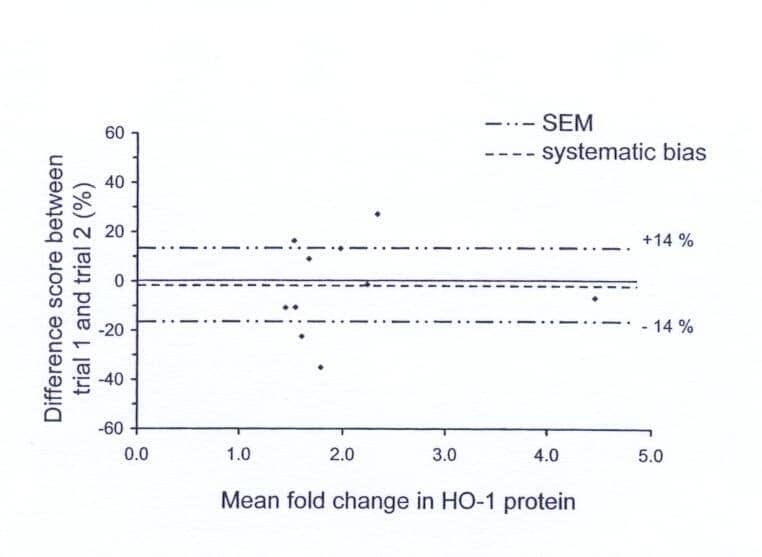The altered expression of the haem oxygenase-1 (HO-1) gene is used in vitro as a marker of oxidative stress (Tyrrell and Basu-Modak, 1994). This gene may also represent a useful marker of oxidative stress in vivo, although the reproducibility of the response to oxidant treatment first needs to be determined (Offord et al. 2000). The aim of the present investigation was to assess the reproducibility of the level of induction of HO-1 protein following hydrogen peroxide (H2O2) treatment in freshly harvested monocytes and lymphocytes. After local ethics approval, ten male subjects (age 26 ± 4 y, height 1.77 ± 0.02 m, and body mass 80 ± 3 kg; mean ± S.D.) reported to the laboratory following an overnight fast on two occasions, separated by two weeks. Subjects rested in a supine position for ten min prior to a venous blood sample (25ml) being taken. Mononuclear cells were isolated from peripheral blood and exposed to 50 μM H2O2 for 30 min at 37°C. HO-1 protein was analysed by flow cytometry (FACScan, Becton Dickinson, USA) at 4, 6, 24 and 48 h after treatment. HO-1 protein was expressed as the fold change in the median fluorescence intensities of the treated vs. sham-treated controls. Peak HO-1 induction values were analysed for reproducibility between trials using the % change in the mean and the standard error of the measurement (SEM) as a % coefficient of variation (CV) as described by Bland and Altman (1996). Retest correlation for each pair of observations was also determined. Statistical significance was accepted at P ≤ 0.05. The % change in the mean ± SEM as a % CV for peak HO-1 induction was −2 ± 14 % and 13 ± 18 % in lymphocytes and monocytes respectively (figure 1). There was no systematic bias at any timepoint, indicating no systematic difference in the response between trials. Retest correlation was significant for peak HO-1 induction in both lymphocytes (r = 0.92, P ≤ 0.01) and monocytes (r = 0.67, P ≤ 0.05). These findings demonstrate that the level of peak HO-1 protein induction in human lymphocytes and monocytes is a reproducible response to H2O2 treatment.
King's College London (2005) J Physiol 565P, PC20
Communications: Reproducibility of haem oxygenase-1 protein induction following hydrogen peroxide treatment in human lymphocytes and monocytes
Markovitch, Daniella ; Thompson, Dylan ; Tyrrell, Rex M;
1. Sport and Exercise Science, School for Health, University of Bath, Bath, United Kingdom. 2. Department of Pharmacy & Pharmacology, University of Bath, Bath, United Kingdom.
View other abstracts by:
Figure 1: Reproducibility of peak HO-1 induction in lymphocytes. Data represent the differences (%) between trials 1 and 2 expressed relative to the mean fold change of the two measurements in HO-1 protein for each subject.
Where applicable, experiments conform with Society ethical requirements.

